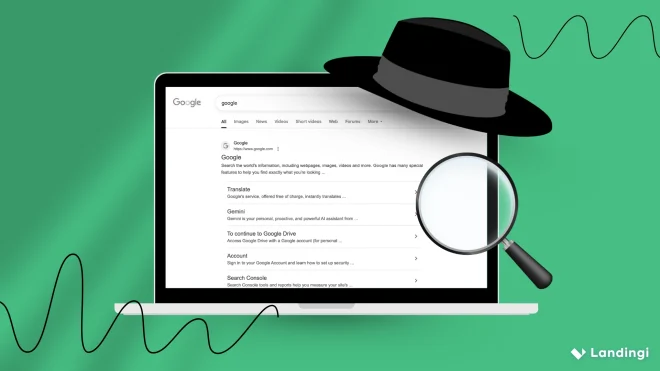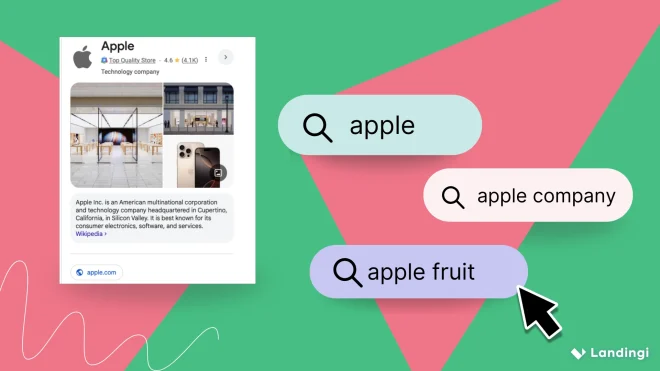Bing SEO refers to the process of optimizing websites specifically for the Bing search engine, using methods that align with Bing’s search engine ranking algorithm and its unique ranking factors. While often overshadowed by Google, Bing handles a massive 900 million searches every single day, as highlighted in MageComp statistics. To put that in perspective, that’s roughly 27 billion searches a month, 37.5 million every hour, and a staggering 625,000 searches happening every minute. Bing is undoubtedly a valuable traffic source, especially in business and high-income user segments.
How can you leverage its full potential? This article provides a complete Bing SEO guide, including clear definitions, measurable benefits, and actionable Bing SEO tips for better results. Whether you’re just starting out or looking to fine-tune your Bing SEO optimization, this guide shows you exactly how to boost your performance and improve your Bing rankings and overall visibility.

What Is Bing SEO?
Bing SEO is the process of tweaking your website to increase its visibility and improve its rankings on Bing‘s search engine results pages (SERPs). It involves on-page optimization (like keyword usage and content structure), off-page optimization (such as link building and social signals), and technical SEO (website speed and mobile-friendliness) – to align with the nuances of Bing’s search algorithm.
It’s crucial to understand that while many SEO best practices are universal, Bing’s evaluation criteria and the weight it assigns to different ranking factors can differ in notable ways from Google’s. Therefore, a dedicated Bing SEO approach ensures that your website is not just optimized for the dominant search engine but also positioned to capture traffic from the significant user base that Bing serves.
Why Is SEO for Bing Important?
Paying attention to SEO for Bing is a smart move because it opens you up to a unique user base and provides additional visibility that can generate significant traffic, especially from desktop and voice search users.
According to WordStream’s analysis, Bing plays a substantial role in the US search landscape, powering over a third (36%) of all desktop searches. This is largely due to its integration with Windows, Microsoft Edge, and Office. Therefore, ignoring Bing means missing out on nearly one–third of potential U.S. desktop traffic.
Moreover, Bing users have higher conversion potential. Research by NumberAnalytics shows that Bing users tend to be older than average internet users, have higher incomes, and show higher engagement levels, leading to higher conversion rates than Google in some verticals. Another aspect is lower competition than Google – Bing SEO is less saturated. This means websites can often achieve top rankings with less effort, especially in niche industries.
Overall, Bing SEO increases visibility across Microsoft’s ecosystem, reaches a high-value audience, and benefits you from lower competition and higher conversion rates. For businesses seeking full organic search coverage, optimizing for Bing is a strategic necessity
Bing users click too—make sure they convert! Start building optimized pages with Landingi.
What Are the Benefits of Bing SEO?
Focusing on Bing SEO can offer real strategic benefits, including reaching a distinct user base, often seeing quicker rankings improvements, and tapping into good conversion potential. It’s a smart way for businesses to expand their organic search presence beyond Google.
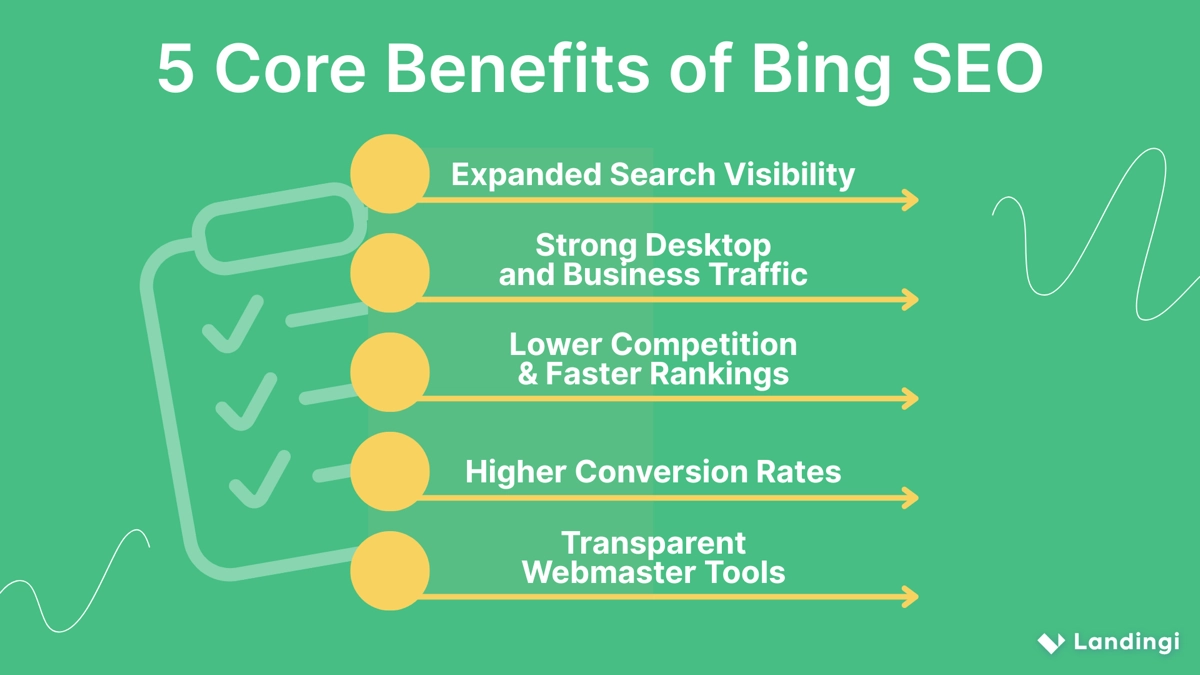
1. Expanded Search Visibility
Bing SEO broadens your visibility across various platforms. It’s not limited to just bing.com; your content can also show up on Yahoo, DuckDuckGo (for certain searches), and within Microsoft products like Windows Search, Microsoft Edge, and Cortana. By optimizing for Bing, you enable your content to appear seamlessly in these interconnected services.
2. Strong Desktop and Business Traffic
As noted earlier, Bing commands a substantial share of the desktop search market in the U.S. Many Bing users tend to access search through office computers and default browsers like Edge, which highlights its importance for B2B companies and professional services.
3. Lower Competition and Faster Rankings
Many SEO strategies tend to concentrate on Google, which makes Bing’s search results less crowded. This reduced competition offers quicker indexing and a chance for small and medium-sized businesses to secure top rankings more easily.
4. Higher Conversion Rates
As Bing users represent a different audience than typical internet users – they tend to be older and more affluent – they show higher conversion potential, especially in sectors like finance, ecommerce, and health, as various reports prove. This is due to higher buyer intent and decision-readiness.
5. Transparent Webmaster Tools
Bing Webmaster Tools (Bing’s equivalent to Google Search Console)offers detailed data on backlinks, keyword impressions, and crawl issues. These tools provide actionable insights with fewer algorithmic fluctuations, allowing for more stable, long-term SEO growth.
What Is the Difference Between Bing SEO and Google SEO?
The difference between Bing SEO and Google SEO lies in their ranking factors, indexing priorities, and algorithm behavior. Bing SEO favors keyword precision, backlink authority, and multimedia content. Google SEO is more dynamic, relying on search intent, user engagement, and AI-driven content relevance.
Moreover, the huge difference lies in the algorithm’s behavior. Google’s algorithm updates are more frequent and volatile. Bing’s updates are less disruptive, offering more stable rankings over time. This makes Bing SEO more predictable for long-term optimization. However, optimizing for both Bing and Google requires adjusting the strategy to each engine’s algorithmic priorities.
Capture Bing traffic and boost conversions with landing pages that work!
How SEO Works in Bing?
Bing SEO works by aligning your website’s content and structure with Bing’s ranking algorithm, which emphasizes clarity, keyword usage, and authority. It operates on a set of ranking factors and optimization strategies that, while sharing some similarities with Google, have distinct priorities and nuances. According to Microsoft’s official Bing Webmaster Guidelines, Bing favors websites that have:
- Clear keyword targeting
- Backlink quality over quantity
- Social signals
- Multimedia content
- Domain age and branding
First, Bing crawls and indexes content, scanning your website based on your XML sitemap, internal links, and robots.txt instructions. Clear URLs, crawlable menus, and frequent updates help Bing discover and index your pages efficiently. Then, it evaluates on-page SEO, paying attention to exact-match keywords in page titles, meta descriptions, headers, and body text.
Then, it’s all about how good and easy to read your content is. Bing tends to rank sites higher if they have a clear focus, use headings well to break things up, keep paragraphs concise, and have good overall formatting. Just be aware that keyword stuffing will actually count against you. Another factor that matters is backlink authority. Bing prefers high-quality, authoritative backlinks from related sites, particularly from trusted domains.
Click-through rate, dwell time, and bounce rate are key user engagement metrics that Bing measures and uses to rank your page. Pages that keep visitors longer and offer clear navigation are favored. Similarly to Google SEO, mobile responsiveness and fast load times are crucial. Additionally, Bing tracks social signals – while it’s a minor factor, high social visibility can improve rankings indirectly by increasing brand authority.
7 Steps for Improving SEO Traffic in Bing
Now that you know how Bing’s algorithm processes content, relevance, and trust, it’s time to discover proven methods for improving SEO traffic. This section outlines a seven-step, actionable framework designed to increase your website’s visibility, crawlability, and ranking performance in Bing’s search engine results. The following steps address key factors in Bing SEO – from keyword placement to structured data – based on what Bing rewards most consistently:
- Get Familiar with Bing Webmaster Tools
- Optimize for Exact-Match Keywords
- Enhance User Experience
- Build High-Quality Backlinks
- Leverage Social Media Signals
- Implement Structured Data
- Monitor and Adjust Strategies
Step 1: Use Bing Webmaster Tools
Begin by registering your website with Bing Webmaster Tools. This platform provides insights into how Bing crawls and indexes your site, identifies potential issues, and offers data on search performance. It works similarly to Google Search Console but focuses on Bing’s specific indexing and ranking systems.
To get started, you’ll need to prove you own your website. You can do this by adding a meta tag, uploading an XML file, or using a DNS record. Once you’ve done that, Bing Webmaster Tools unlocks a bunch of useful information, like any problems Bing had crawling your site, which of your pages are actually in Bing’s search results, who’s linking to you, how you’re performing in Bing search, and how often your keywords are being seen.
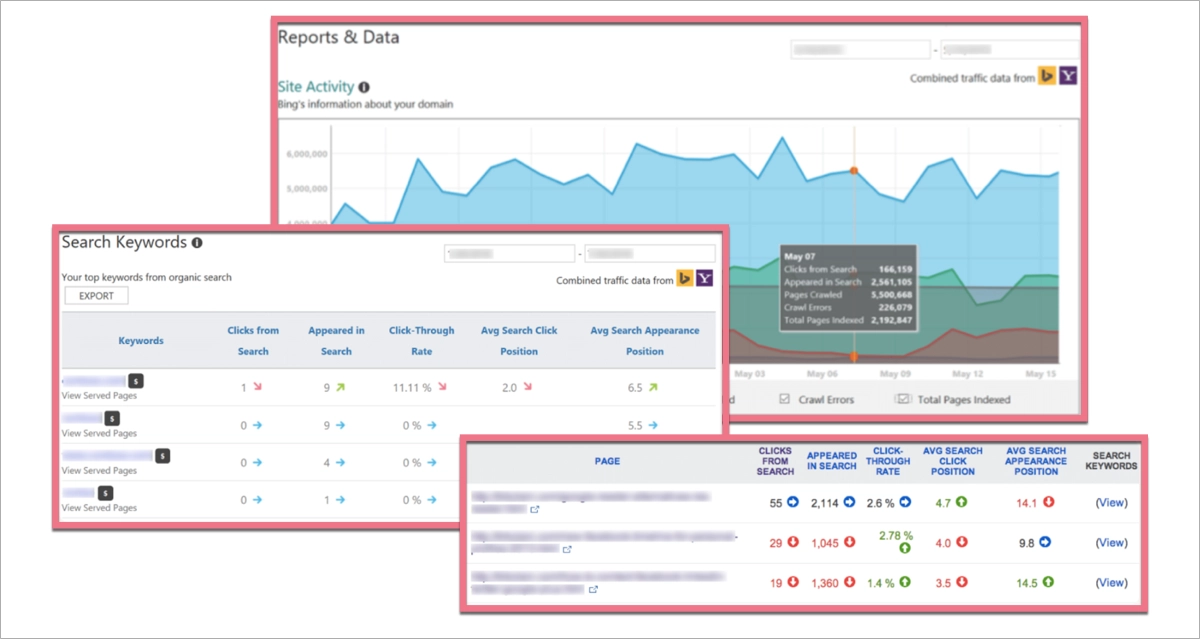
In the context of search engine optimization, this platform allows you to:
- Submit your sitemap so Bing can discover your pages more efficiently.
- Analyze keyword performance to identify which queries bring traffic and where you can improve.
- Identify crawl issues, such as blocked resources or broken links, that hinder visibility.
- Disavow toxic backlinks that could harm your domain’s authority in Bing’s ranking system.
By keeping an eye on this information regularly, you can tweak how your content is organized, fine-tune the keywords you’re targeting, and ensure your site is always easy for Bing to find and consider relevant. This directly supports SEO traffic improvement by making your website easier to crawl, index, and rank.
Step 2: Optimize for Exact-Match Keywords
Next up, it’s essential to focus on using the exact words and phrases people actually type into Bing when they’re searching. This is one area where Bing and Google are a bit different. While Google relies heavily on semantic interpretation, Bing pays closer attention to whether you‘ve used the exact keywords someone searched for.
To apply this effectively, use the primary keyword – the exact phrase someone would search for – right at the start of your page title, in your main heading (H1), and the first paragraph. Then, weave it naturally into your subheadings and the rest of your content, ensuring it still reads well. This clarifies what your page is about and helps Bing’s algorithm figure out how relevant it is.
Additionally, include the target phrase in your URL slug and image file names. While meta keywords have minimal impact today, ensuring consistency between visible content and metadata still supports credibility in Bing’s index.
Avoid using irrelevant keywords or keyword stuffing, as this can harm performance and reduce user trust. Instead, keep each page tightly focused on one main query. This improves your chances of ranking websites for specific search intents, particularly those with clear commercial or informational goals.
In short, optimizing for exact-match keywords helps Bing quickly understand your topic, boosts topical relevance, and directly improves SEO traffic by matching user search queries with your most important pages.
Step 3: Enhance User Experience
After keyword optimization, improving the overall user experience is essential for sustainable Bing SEO traffic. Bing strongly emphasizes how users interact with a website, focusing on clarity, usability, and engagement signals that reflect real value.
To begin, ensure your website structure is easy to navigate. Menus should be intuitive, content should be grouped logically, and key information must be accessible within one or two clicks. This reduces bounce rates and increases session duration, both of which are signals Bing considers when ranking web pages.
One of the most critical technical aspects is page load speed. Bing favors fast-loading websites because slow pages disrupt the user experience. To improve performance across all devices, make your images smaller, get rid of any extra code that’s slowing things down, and turn on caching to help your site load faster. Equally important is responsiveness for mobile users. Although Bing is more desktop–oriented than Google, mobile traffic is still significant. A responsive layout that adapts to different screen sizes ensures consistent functionality and appearance across devices.
Bing-friendly SEO starts here – and Landingi helps you turn clicks into customers!
Step 4: Build High-Quality Backlinks
In addition to optimizing on-page elements, earning strong backlinks is a crucial step for improving your SEO traffic in Bing. Unlike Google, Bing places even more weight on domain trust and link authority, meaning the sources of your backlinks matter significantly. By building a strong backlink profile, you increase domain authority, boost trustworthiness, and open more opportunities for your content to appear at the top of Bing’s search results.
Focus on acquiring quality links from credible, thematically related domains. These may include industry blogs, news outlets, or educational institutions. Backlinks from other websites that are well-established signal to Bing that your content is reliable and deserves visibility.
You can build these external links by writing guest articles for other sites, working with partners, doing digital PR to get mentions, and creating really valuable content that people will naturally want to link to, like your own research, helpful comparison guides, or interviews with experts. Every natural link you earn is like a vote of confidence for your site in Bing’s eyes, which helps your pages rank higher.
Avoid manipulative tactics like link farms or mass directory submissions, as Bing actively penalizes these low–value linking practices. Instead, focus on sustainable outreach and relationship-building that earns links organically.
Step 5: Leverage Social Media Signals
Moving forward, integrating social media into your SEO strategy can support better visibility. Bing uses social media signals – such as shares, likes, and comments – as part of its ranking considerations. These interactions act as indicators of trust and popularity.
To benefit from this, regularly share your content on popular social media platforms like Facebook, X, and LinkedIn. Encourage engagement by crafting posts that spark discussions or offer direct value. Consistent activity and audience interaction can amplify the reach of your content, increasing the chances that it gets indexed and ranked.
Moreover, Bing crawls social media pages. This means public posts and profiles that link to your website can act as supportive signals, especially if they come from verified or authoritative accounts. As your content gains traction, Bing associates it with higher credibility and may boost its position in search results.
While social media signals alone won’t determine rankings, they can indirectly drive more visits, backlinks, and brand searches – all of which strengthen your site’s overall SEO profile.
Step 6: Implement Structured Data
Additionally, applying structured data to your web pages helps Bing better understand and display your content. Structured data – also known as schema markup – is a form of code added to your HTML that identifies the meaning behind key elements like products, articles, reviews, and events.
To implement it effectively, use Schema.org vocabulary to tag content types. For example, mark up product names, prices, ratings, and availability using the “Product” schema. If you publish articles, use “Article” or “BlogPosting” schema to define titles, authors, and publication dates. This markup makes your content machine-readable, allowing Bing to categorize it with greater accuracy.
By implementing structured data on your website, you’re also unlocking the potential for enhanced search features like rich snippets, image previews, and those handy FAQ dropdowns. These aren’t just cosmetic improvements – they make your listings stand out and provide more immediate information to searchers, which can significantly boost your visibility and encourage more clicks from Bing’s search results.
TIP: Bing Webmaster Tools offers a Markup Validator that lets you test your structured data and ensure it’s correctly applied.
Step 7: Monitor and Adjust Strategies
Finally, consistent monitoring is essential to maintain and grow your SEO traffic in Bing. Use Bing Webmaster Tools to track how your keywords are performing, how often people are clicking on your links in the search results, and whether Bing is actually indexing your pages.
As you get this data, be ready to tweak your content, the links you have, and even the technical parts of your site to match what’s working best. Over time, this ability to adapt will help you stay relevant as search engines change and how people search evolves. Regular optimization is key to seeing results that last.
10 Key Bing Ranking Factors
Key Bing ranking factors include exact–match keywords, high-quality and fresh content, backlinks from authoritative sites, on–page SEO structure, user experience, social signals, domain authority, multimedia content, local SEO factors, and technical SEO aspects. Bing uses a more traditional algorithm than Google, making its signals more predictable and easier to optimize for.
Check out the detailed list of Bing ranking factors and consider how each aligns with your current SEO strategy to maximize your visibility in Bing SERPs.
1. Exact-Match Keywords
Bing’s algorithm favors pages that clearly reflect the user’s query. Including the exact keyword phrase in the title tag, H1 header, and meta description increases your visibility. It signals direct alignment between the query and your content, helping Bing assess relevance faster and with more certainty.
TIP: Place the exact-match keyword in your URL slug to reinforce topical clarity and boost ranking potential.
2. High-Quality, Fresh Content
Like other search engines, Bing prioritizes accurate, up–to–date, and useful content. Pages that you update regularly or new articles you publish tend to do better in the rankings, especially in competitive or time-sensitive topics. Freshness signals that your site is active and maintaining relevance for current search interests.
TIP: Add publication and last-updated dates to your articles to help Bing recognize content freshness more easily.
3. Backlink Quality
High-authority backlinks carry strong weight in Bing’s ranking system. One authoritative link from a credible source can outweigh dozens of weak ones. This search engine focuses on domain trust and context rather than raw link volume, making backlink quality a decisive factor in ranking.
TIP: Monitor competitor backlinks using tools like Ahrefs or Bing Webmaster Tools and try to replicate the highest-authority ones through outreach or content improvement.
4. On-Page SEO Structure
Bing rewards clean, well–organized HTML with clear heading hierarchies (H1, H2, H3), descriptive URLs, and concise meta tags. Proper structure helps Bingbot quickly interpret page relevance and improves crawl efficiency. Plus, when your pages are well-structured, they’re usually easier for people to read, which can lead to better engagement – something Bing also pays attention to.
TIP: Use only one H1 per page with your main keyword, then structure H2s and H3s to reflect clear content sections for better crawlability.
5. User Experience (UX)
A positive UX, such as fast loading, easy navigation, and mobile-friendly design, encourages Bing to rank your site higher. If people quickly leave your page (high bounce rate) or don’t spend much time there (low dwell time), it can signal poor relevance. Fast page load time is also critical to avoid losing users before they engage.
TIP: Use heatmaps, session recordings, and track user behavior (try EventTracker for landing pages) to identify friction points where users drop off, and then streamline those sections.
Rank smart, convert smarter! Use Landingi to maximize your Bing SEO strategy.
6. Social Media Signals
Bing considers public interactions on social platforms when evaluating trust and relevance. When you actively share your content, it creates signals that can improve your ranking in search results. Content with solid social proof tends to draw more attention and often leads to additional backlinks.
TIP: Use consistent posting schedules and visual formats that match popular social media schemes to increase engagement and content visibility.
7. Domain Factors
Domain age, history, and exact–match domains (EMDs) still matter in Bing. A trusted, older domain with relevant keywords in the URL can outrank newer domains even if content quality is equal. Exact-match domains may still offer a slight advantage if the content matches user intent.
TIP: Keep your domain active, avoid frequent ownership changes, and maintain a focused niche to build long-term trust with Bing.
8. Multimedia Content
Bing prefers content that goes beyond plain text. Adding images, videos, and charts increases user interaction and provides additional context for ranking. With its growing visual search capabilities, Bing can extract value from well-optimized visuals as part of content evaluation. Using alt attributes and proper file names helps index this content more effectively. Bing also rewards the use of structured data (schema markup) to help interpret page elements.
TIP: Use descriptive file names and alt text for all images to improve discoverability and support contextual relevance.
9. Local SEO
Bing places high importance on local relevance for geo-targeted searches. Business listings, address consistency, and local keywords help your content appear in local packs and maps. Verified Bing Places profiles also improve visibility for location–based queries.
TIP: Create and maintain a Bing Places for Business listing, and ensure your name, address, and phone number (NAP) are identical across all directories.
Get the most from Bing local SEO! Pair it with high-converting landing pages from Landingi.
10. Technical SEO
Like Google, Bing rewards websites that are fast, secure, and easy to crawl. Proper use of XML sitemaps, robots.txt, canonical tags, and clean URL structures ensures smooth indexing. A technically sound site reduces crawl errors and improves ranking stability.
TIP: Regularly audit your site with Bing Webmaster Tools to fix crawl issues, remove dead links, and validate structured data for optimal performance.
What Are Bing SEO Webmaster Tools?
Bing Webmaster Tools is a free Microsoft platform that helps website owners track and optimize their performance in Bing Search. It offers insights into how Bing crawls, indexes, and ranks your pages, helping you improve visibility and organic traffic.
Key Bing Webmaster Tools’ features include:
- Site Scan that identifies technical SEO issues affecting crawlability,
- URL Inspection that checks indexing status and crawl data for individual URLs,
- Keyword Reports, which showcase impressions, clicks, and ranking positions by search query,
- Backlink Analysis that shows inbound links and referring domains,
- Sitemaps Submission that allows submitting XML sitemaps to speed up indexing,
- Crawl Control that allows adjusting how frequently Bingbot accesses your site.
Using these tools regularly allows you to fix issues early, monitor SEO progress, and align your site with Bing’s ranking signals to improve your website’s performance.
Should I Optimize My Landing Page for Bing SEO?
Given that Bing still holds a noticeable share of the search market and reaches a unique user base, it’s generally a good idea to consider adjusting your landing page SEO for this search engine. Consider this: you’ve dedicated time and effort to create a landing page aimed at converting visitors. By optimizing it for Bing, you can broaden your reach and tap into traffic you might otherwise overlook.
Bing’s Webmaster Tools offer valuable insights into how your page performs on their platform, so incorporating it into your overall SEO strategy could lead to gradual improvements in both visibility and conversions. You don’t need to redo your Google SEO strategy completely; instead, it’s important to carefully consider Bing’s unique preferences when you’re working on on-page elements, building backlinks, and tackling technical SEO.
To optimize your pages for better Bing SEO rankings, consider professional tools, like Landingi. Start by leveraging Landingi’s ready-to-use templates and intuitive editor to design a clean, uncluttered layout that guides visitors toward your primary call-to-action. Bing’s algorithm favors literal keyword matches over synonyms, and Landingi makes it easy to edit these elements and structure your content with clear headings and concise, persuasive copy. You can use AI landing page features to generate relevant, keyword-rich content for your page and SEO copy.

Next, ensure your landing page’s URL is concise, readable, and includes your primary keyword, which you can set directly in Landingi’s SEO settings. As Bing evaluates multimedia content, use high-quality, original visuals and optimize their alt text with relevant keywords – Landingi’s visual editor streamlines this process. Make sure your design is responsive, but prioritize a desktop-first experience, as Bing still indexes desktop layouts first. Test your page on desktop browsers to ensure all elements render properly.
You can also use Landingi’s built-in analytics to monitor your page’s performance, track user engagement, and identify areas for improvement. Consider A/B testing headlines, visuals, and CTAs to maximize both conversion and SEO impact. By following these steps, you’ll create a Bing-optimized landing page that’s both user-friendly and search engine-friendly.
Tap into Bing’s audience and build high-converting landing pages with Landingi.
What Is the Difference Between Local Bing SEO and Local Google SEO?
Local Bing SEO and Local Google SEO share common goals—appearing in local searches and maps—but differ in execution. Bing relies on Bing Maps and Bing Places for Business, while Google uses Google Maps and Google Business Profiles. Both prioritize proximity, relevance, and reviews, but Bing puts more weight on exact keyword matches and consistent citations.
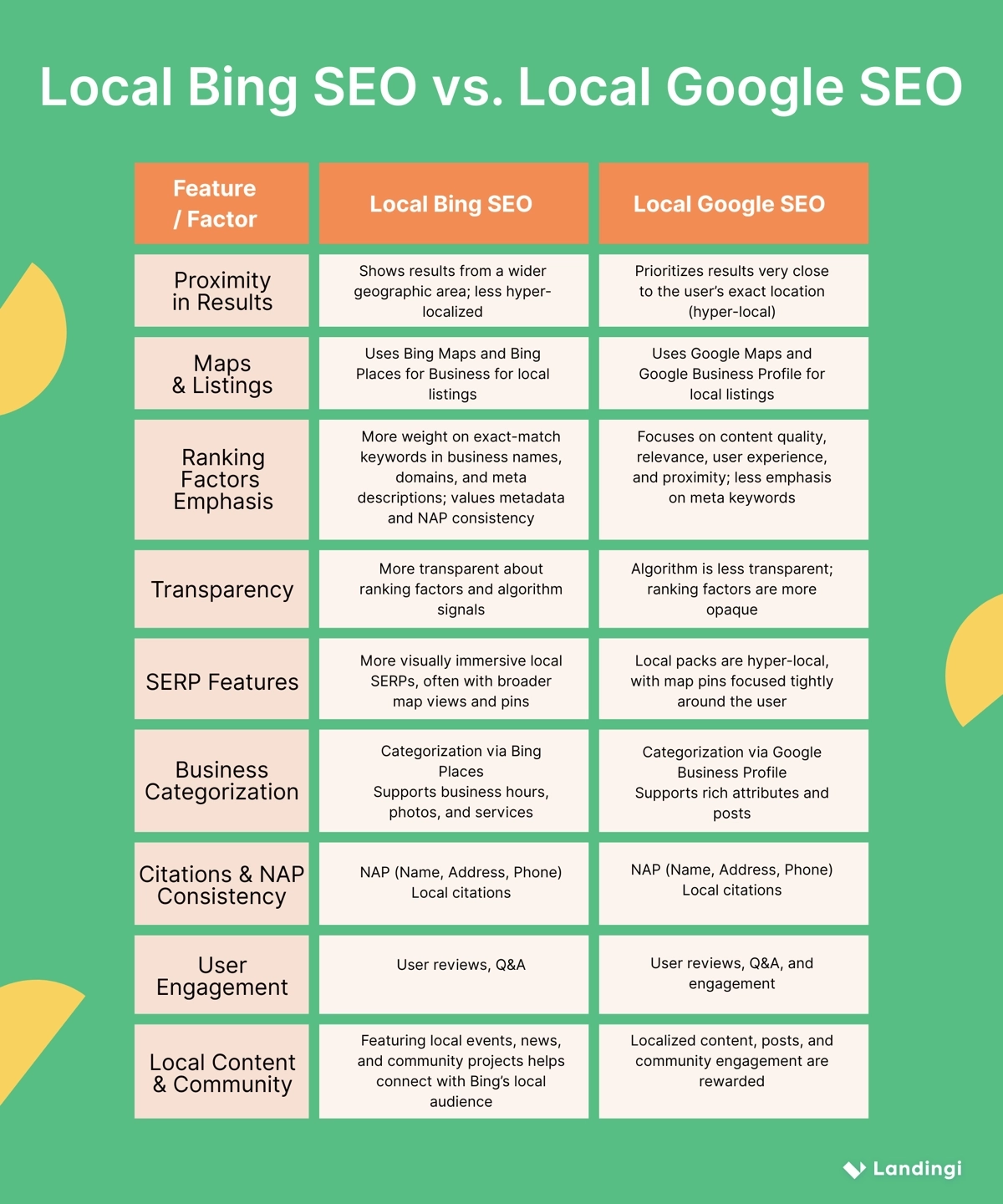
Other search engines may pull from either source, but Bing and Google handle data separately. To boost online visibility, optimize listings on both platforms with accurate NAP info, local keywords, and recent updates – strong profiles improve ranking across all local searches.
What Search Algorithm Does Bing Use?
Bing employs a sophisticated, AI–driven search algorithm that integrates machine learning, deep learning, and advanced vector search techniques to provide highly relevant results. The main components of this system include:
- relevance, which matches user queries to both exact and conceptual content
- quality, which assesses page and domain authority as well as the depth of the content
- context, which considers factors like user location, device type, and intent.
Furthermore, Bing utilizes the Space Partition Tree and Graph (SPTAG) vector search algorithm, allowing it to grasp search concepts and user intent beyond just specific keywords. To enhance the accuracy of its search rankings results, Bing also incorporates user engagement metrics, social signals, and real-time AI models that are even more advanced than those found in ChatGPT.
What Is the Best Bing SEO Tool?
The best Bing SEO tool is Bing Webmaster Tools, a free, official platform from Microsoft that offers a comprehensive suite of features tailored specifically to optimizing your site’s performance in Bing search results. However, you can also use various supportive tools, like a keyword research tool (e.g., Semrush) or a backlink analysis tool (e.g., Ahrefs).
You might be wondering if Google Search Console can help with Bing SEO analysis and optimization. While it’s designed primarily for Google, the good news is that many of the technical and content insights you find there can still be really useful for optimizing for Bing, too.
Think about it: things like site speed issues, mobile-friendliness problems, and even how your content is structured are generally crucial for all search engines, including Bing. So, while Google Search Console won’t give you Bing-specific data like keyword performance on Bing, the fundamental health checks and content improvements it highlights can indirectly benefit your Bing SEO efforts as well. However, these two most popular tools differ in features, data, and interface. Here’s a comparison table highlighting the main distinctions:
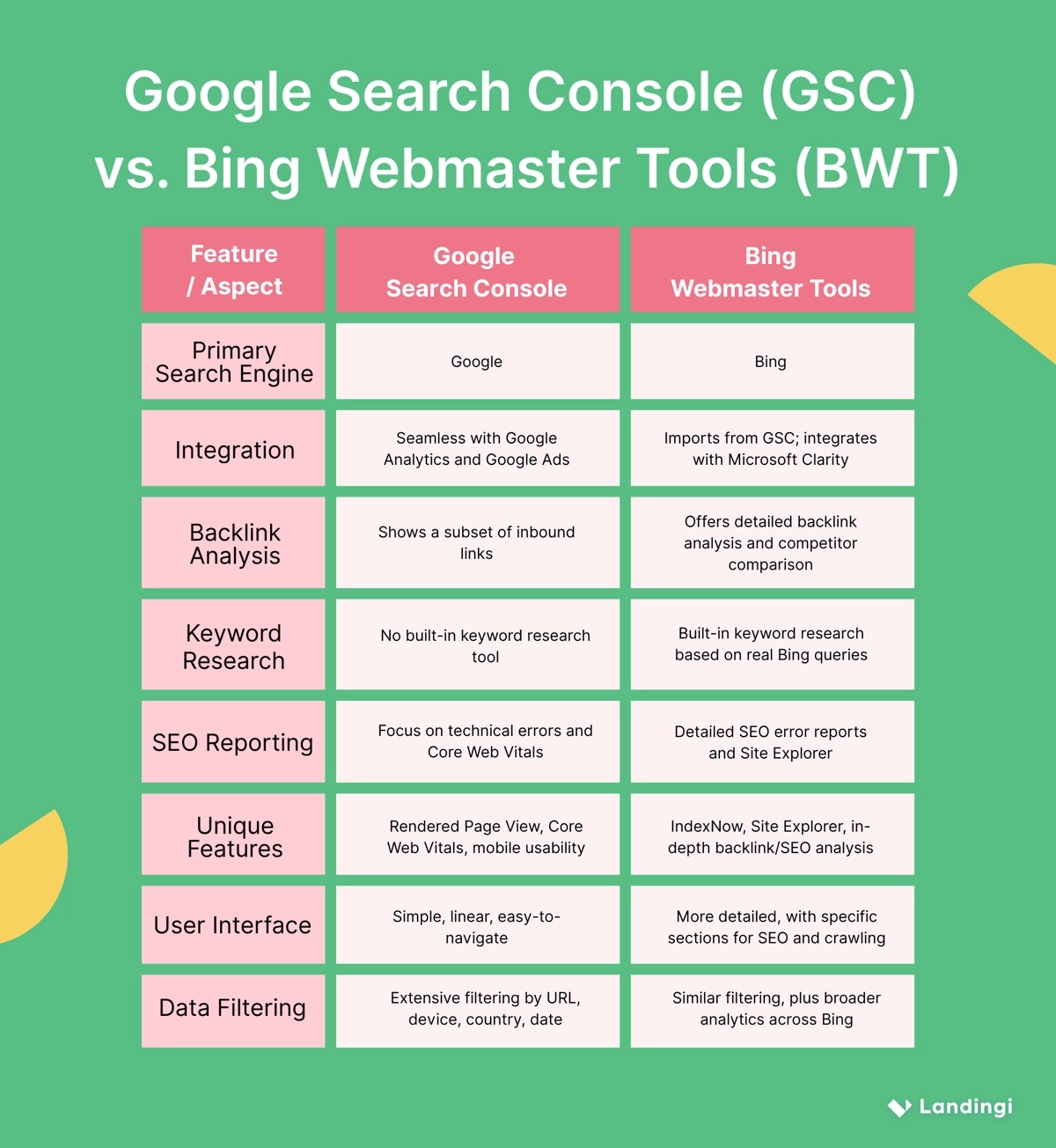
Where to Find the Best Bing SEO Services?
The best Bing SEO services are typically offered by experienced SEO agencies, digital marketing firms, and consultants with proven results in Microsoft’s ecosystem. To find them, look for providers who specifically mention Bing or multi-engine optimization in their service scope:
- Specialized SEO agencies with case studies on Bing performance or Microsoft partnerships,
- Freelancer professionals with Bing SEO expertise (check out Upwork or Clutch),
- Microsoft Advertising partners, providing Bing SEO alongside paid ad services.
When looking to hire someone for Bing SEO, ensure they really know their stuff when it comes to Bing’s specific ranking factors. They should be able to do technical check-ups, get you going with Bing Webmaster Tools, figure out the right keywords for Bing searches, and have strategies for building the kind of backlinks that Bing values.
What Are the Limitations of Bing SEO?
The limitations of Bing SEO stem mainly from its narrower reach and slower indexing speed compared to Google. Although Bing offers valuable traffic, especially on desktop, its audience is smaller and less diverse.
Optimizations may not yield fast results, as Bing crawls and updates content less frequently. Data in Bing Webmaster Tools can also lag behind. Appearance in Bing’s SERPs often depends heavily on exact-match keywords, limiting flexibility in content style.
Additionally, while integration with the Microsoft Edge browser increases exposure, mobile market share remains low, reducing visibility across devices. This makes Bing SEO the best choice for use as a complement, not as a sole strategy.
Use Bing SEO to Boost Traffic on Your Landing Pages
Bing SEO optimization offers a clear opportunity to expand your organic reach, especially on desktop devices and within Microsoft’s product ecosystem. By aligning your landing pages with Bing ranking signals – like keyword precision, site structure, and content clarity – you position your site for consistent visibility.
Following a dedicated Bing SEO guide ensures you address what Bing values most – applying proven Bing SEO tips, such as using exact-match keywords, structured data, and fast-loading pages, can significantly improve engagement and conversions.
Understanding Bing ranking factors and how the Bing search engine ranking algorithm evaluates content enables smarter decisions. By optimizing for clarity and speed, and targeting relevant backlinks, you increase your visibility where competition is lower and conversions are often higher. The keys to turning Bing’s traffic into real business results lie in page optimization. Use Landingi to create winning landing pages – focus on precision, structure, and relevance, and take over the first positions in Bing’s SERPs.



